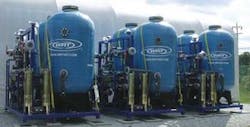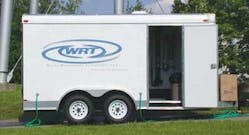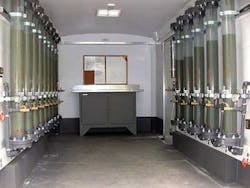by Duane Bollig
In 2000, the EPA revisited regulations and monitoring requirements for the presence of radionuclides in drinking water. While most radioactive materials that are present in water supplies are naturally occurring, over time they can present considerable human health risks when allowed to reach unsafe levels in drinking water.
One such radionuclide is radium (specifically radium-226 and radium- 228), for which the EPA set the maximum contaminant level (MCL) at five picocuries per liter (pCi/L) in 1976. In 2000, the EPA re-confirmed this MCL and established regulations for monitoring of radium levels in public water systems, with a mandate for communities to plan for or reach compliance with the MCL by the end of 2007.
Since this adjustment, U.S. communities large and small have more closely monitored radium levels in drinking water to comply with the revised Safe Drinking Water Act. Discovering in some cases that radium levels were above the MCL, many communities have since installed systems to mitigate the potential health risks from drinking water contaminated with radium.
Of the various technologies that exist to remove radium from drinking water, one successful approach, offered by Water Remediation Technology (WRT) of Wheat Ridge, CO, involves passing radium-contaminated water through a fluidized ion-exchange bed of zeolite-based treatment media, a natural industrial mineral substance onto which the radium attaches. At scheduled intervals, the treatment media is exchanged and disposed of in a licensed facility, reducing radium in the drinking water to a safe level in an environmentally friendly way that eliminates the risk of re-contaminating the local environment with the radium treatment residuals.
Each new installation of WRT’s Z-88® Radium Treatment Process begins with a pilot study to demonstrate the effectiveness of the treatment process in that region and establish design parameters for the full-scale system. Typically the pilot study will run for approximately 100-115 days to ensure that the pilot unit successfully meets the EPA requirements for radium compliance throughout the study and to show consistency in the system overall.
A self-contained, mobile system, the pilot unit typically consists of four to eight four-inch-diameter columns measuring four vertical feet. Each column contains approximately three feet of Z-88® treatment media. The columns are either mounted inside of the pilot trailer, which is located near the pump house, or mounted onto a small, modular frame structure that is placed inside the pump house. For the benefit of visual observation of the treatment process, columns in the pilot unit are clear. In addition, the number of columns may vary depending on the radium concentration in the water and the length of the pilot test.
Since the pilot unit is self-contained, set-up consists only of connecting to both the water source and the discharge line, adjusting the feed to the desired pilot flow rate, and checking the operation of all components. Once the system is activated, water enters the unit through a ¾-inch diameter hose, passes through a control valve and flow meter, and then enters the bottom of the first column. Water exits at the top of the first column and then travels to the bottom of the second column through a hose of the same diameter. This series then follows for each subsequent column, following an up-flow pattern, with the pressure generated from the well source providing the force for the water to move through the treatment system.
The flow rate for pilot units is typically set at approximately one gallon per minute (GPM).
As the water travels from column to column, the radium attaches to the treatment media within and the water then passes through a discharge filter. At the point of exit, the radium in the water has been reduced to a concentration level safe for regular human consumption. At no point in the treatment process are chemicals added to the water. Instead, the Z-88® system operates for the most part independently, allowing the treatment media to remove radium from the water as it passes through the system.
To be expected with normal progression of the system, the treatment media eventually becomes “loaded” or “spent” with radium. Periodically, at intervals typically designed to be between one to two years, technicians exchange the spent treatment media and dispose of it in a licensed facility. Using this disposal method for the treatment residuals, the system operates without generating a liquid waste stream and without impacting the local environment by re-introducing the radioactive residuals and potentially contaminating another water supply. The handling and exchange of spent media for new media, as well as the shipping and disposal into licensed disposal sites, is handled by WRT.
Out of more than 50 pilot studies conducted to date, the Z-88® system has consistently reduced the gross alpha and radium content to below the MCL as defined by the EPA. Throughout the pilot study and after the installment of the permanent system, water samples are regularly collected to test for radioactive materials and ensure the system is functioning properly.
Since the installment of WRT’s first water radium removal system in Oswego, Ill., in 2005, pilot units and full scale Z-88® radium removal systems are currently operating in several states across the country, including Illinois, New Jersey, New York, North Carolina and Wisconsin. The pilot systems have successfully modeled full-scale water treatment systems ranging in capacity from less than 50 to more than 1,600 gpm.
The full-scale treatment systems have been effectively complying with the new mandated EPA regulations, reducing the radium content in water to safe levels and diminishing the harmful effects of radium after prolonged consumption.
About the Author:
Duane Bollig joined WRT in April 2003 as the vice president of environmental and government affairs. In this role, he directs the radiological licensing process and radiation safety program of the company’s water treatment systems. He is also the Radiation Safety Officer for WRT.






